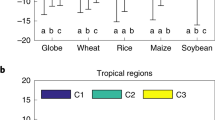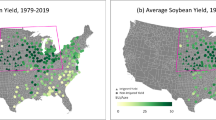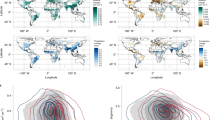Abstract
Our understanding of the impact of climate change on global coffee production is largely based on studies focusing on temperature and precipitation, but other climate indicators could trigger critical threshold changes in productivity. Here, using generalized additive models and threshold regression, we investigate temperature, precipitation, soil moisture and vapour pressure deficit (VPD) effects on global Arabica coffee productivity. We show that VPD during fruit development is a key indicator of global coffee productivity, with yield declining rapidly above 0.82 kPa. The risk of exceeding this threshold rises sharply for most countries we assess, if global warming exceeds 2 °C. At 2.9 °C, countries making up 90% of global supply are more likely than not to exceed the VPD threshold. The inclusion of VPD and the identification of thresholds appear critical for understanding climate change impacts on coffee and for the design of adaptation strategies.
This is a preview of subscription content, access via your institution
Access options
Access Nature and 54 other Nature Portfolio journals
Get Nature+, our best-value online-access subscription
$29.99 / 30 days
cancel any time
Subscribe to this journal
Receive 12 digital issues and online access to articles
$119.00 per year
only $9.92 per issue
Buy this article
- Purchase on Springer Link
- Instant access to full article PDF
Prices may be subject to local taxes which are calculated during checkout





Similar content being viewed by others
Data availability
The analysis is based on publicly available datasets. TerraClimate data are from http://www.climatologylab.org/terraclimate.html. Coffee yield data are from http://www.fao.org/faostat/en/#home. Coffee mapping data are from https://www.mapspam.info/.
Code availability
Code to replicate the key threshold analysis results of the study is at https://doi.org/10.7910/DVN/QETV5H. Correspondence and requests for additional materials should be addressed to J. Kath (jarrod.kath@usq.edu.au).
References
Vega, F. E., Rosenquist, E. & Collins, W. Global project needed to tackle coffee crisis. Nature 425, 343 (2003).
Craparo, A. C. W., Van Asten, P. J. A., Läderach, P., Jassogne, L. T. P. & Grab, S. W. Coffea arabica yields decline in Tanzania due to climate change: global implications. Agric. For. Meteorol. 207, 1–10 (2015).
Davis, A. P. et al. High extinction risk for wild coffee species and implications for coffee sector sustainability. Sci. Adv. 5, eaav3473 (2019).
Davis, A. P., Gole, T. W., Baena, S. & Moat, J. The impact of climate change on indigenous arabica coffee (Coffea arabica): predicting future trends and identifying priorities. PLoS ONE 7, e47981 (2012).
Davis, A. P., Mieulet, D., Moat, J., Sarmu, D. & Haggar, J. Arabica-like flavour in a heat-tolerant wild coffee species. Nat. Plants 7, 413–418 (2021).
Moat, J., Gole, T. W. & Davis, A. P. Least concern to endangered: applying climate change projections profoundly influences the extinction risk assessment for wild Arabica coffee. Global Change Biol. 25, 390–403 (2019).
Moat, J. et al. Resilience potential of the Ethiopian coffee sector under climate change. Nat. Plants 3, 17081 (2017).
Kath, J. et al. Not so robust: Robusta coffee production is highly sensitive to temperature. Global Change Biol. 26, 3677–3688 (2020).
Liu, L. et al. Soil moisture dominates dryness stress on ecosystem production globally. Nat. Commun. 11, 1–9 (2020).
Grossiord, C. et al. Plant responses to rising vapor pressure deficit. New Phytol. 226, 1550–1566 (2020).
IPCC Climate Change 2022: Impacts, Adaptation, and Vulnerability (eds. Pörtner, H.-O. et al.) (Cambridge Univ. Press, 2022).
Burke, M. et al. Higher temperatures increase suicide rates in the United States and Mexico. Nat. Clim. Change 8, 723–729 (2018).
Burke, M., Hsiang, S. M. & Miguel, E. Global non-linear effect of temperature on economic production. Nature 527, 235–239 (2015).
Duffy, K. A. et al. How close are we to the temperature tipping point of the terrestrial biosphere? Sci. Adv. 7, eaay1052 (2021).
Scheffer, M. et al. Early-warning signals for critical transitions. Nature 461, 53–59 (2009).
Schneider, S. H. Abrupt non-linear climate change, irreversibility and surprise. Global Environ. Change 14, 245–258 (2004).
Lenton, T. M. Early warning of climate tipping points. Nat. Clim. Change 1, 201–209 (2011).
Lenton, T. M. et al. Climate tipping points—too risky to bet against. Nature. 575, 592–595 (2019).
Lobell, D. B., Bänziger, M., Magorokosho, C. & Vivek, B. Nonlinear heat effects on African maize as evidenced by historical yield trials. Nat. Clim. Change 1, 42–45 (2011).
Lobell, D. B., Deines, J. M. & Tommaso, S. D. Changes in the drought sensitivity of US maize yields. Nat. Food 1, 729–735 (2020).
Lobell, D. B. et al. Greater sensitivity to drought accompanies maize yield increase in the US Midwest. Science 344, 516–519 (2014).
Rigden, A., Mueller, N., Holbrook, N., Pillai, N. & Huybers, P. Combined influence of soil moisture and atmospheric evaporative demand is important for accurately predicting US maize yields. Nat. Food 1, 127–133 (2020).
Schlenker, W. & Roberts, M. J. Nonlinear temperature effects indicate severe damages to US crop yields under climate change. Proc. Natl Acad. Sci. USA 106, 15594–15598 (2009).
McDowell, N. G. et al. Mechanisms of woody-plant mortality under rising drought, CO2 and vapour pressure deficit. Nat. Rev. Earth Environ. 3, 294–308 (2022).
Sinclair, T. R. et al. Limited-transpiration response to high vapor pressure deficit in crop species. Plant Sci. 260, 109–118 (2017).
López, J., Way, D. A. & Sadok, W. Systemic effects of rising atmospheric vapor pressure deficit on plant physiology and productivity. Global Change Biol. 27, 1704–1720 (2021).
McDowell, N. G. & Allen, C. D. Darcy’s law predicts widespread forest mortality under climate warming. Nat. Clim. Change 5, 669–672 (2015).
Abatzoglou, J. T., Dobrowski, S. Z., Parks, S. A. & Hegewisch, K. C. TerraClimate, a high-resolution global dataset of monthly climate and climatic water balance from 1958–2015. Sci. Data 5, 170191 (2018).
You, L., Wood, S., Wood-Sichra, U. & Wu, W. Generating global crop distribution maps: from census to grid. Agric. Syst. 127, 53–60 (2014).
Fong, Y., Huang, Y., Gilbert, P. B. & Permar, S. R. chngpt: threshold regression model estimation and inference. BMC Bioinformatics 18, 1–7 (2017).
Qin, Y. et al. Agricultural risks from changing snowmelt. Nat. Clim. Change 10, 459–465 (2020).
Forster, P. M., Maycock, A. C., McKenna, C. M. & Smith, C. J. Latest climate models confirm need for urgent mitigation. Nat. Clim. Change 10, 7–10 (2020).
Forster, P. M. et al. Projections of when temperature change will exceed 2 °C above pre-industrial levels. Nat. Clim. Change 10, 407–412 (2011).
Joshi, M., Hawkins, E., Sutton, R., Lowe, J. & Frame, D. Projections of when temperature change will exceed 2 °C above pre-industrial levels. Nat. Clim. Change 1, 407–412 (2011).
IPCC, 2021: Summary for Policymakers. In Climate Change 2021: The Physical Science Basis (eds Masson-Delmotte, V. et al.) (Cambridge Univ. Press, in press).
Lobell, D. B. et al. The critical role of extreme heat for maize production in the United States. Nat. Clim. Change 3, 497–501 (2013).
Sinclair, T. R., Hammer, G. L. & Van Oosterom, E. J. Potential yield and water-use efficiency benefits in sorghum from limited maximum transpiration rate. Funct. Plant Biol. 32, 945–952 (2005).
Martins, M. Q. et al. Protective response mechanisms to heat stress in interaction with high [CO2] conditions in Coffea spp. Front. Plant Sci. 7, 947 (2016).
Rodrigues, W. P. et al. Long‐term elevated air [CO2] strengthens photosynthetic functioning and mitigates the impact of supra‐optimal temperatures in tropical Coffea arabica and C. canephora species. Global Change Biol. 22, 415–431 (2016).
Ghini, R. et al. Coffee growth, pest and yield responses to free-air CO2 enrichment. Clim. Change 132, 307–320 (2015).
Rakocevic, M. et al. The vegetative growth assists to reproductive responses of Arabic coffee trees in a long-term FACE experiment. Plant Growth Regul. 91, 305–316 (2020).
Hammer, G. L. et al. Designing crops for adaptation to the drought and high‐temperature risks anticipated in future climates. Crop Sci. 60, 605–621 (2020).
Gennari, P., Rosero-Moncayo, J. & Tubiello, F. N. The FAO contribution to monitoring SDGs for food and agriculture. Nat. Plants 5, 1196–1197 (2019).
Lesk, C., Rowhani, P. & Ramankutty, N. Influence of extreme weather disasters on global crop production. Nature 529, 84–87 (2016).
Ortiz-Bobea, A., Ault, T. R., Carrillo, C. M., Chambers, R. G. & Lobell, D. B. Anthropogenic climate change has slowed global agricultural productivity growth. Nat. Clim. Change 11, 306–312 (2021).
Davis, A. P. et al. Hot coffee: the identity, climate profiles, agronomy, and beverage characteristics of Coffea racemosa and C. zanguebariae. Front. Sustain. Food Syst. 5, 740137 (2021).
Sarmiento-Soler, A. et al. Disentangling effects of altitude and shade cover on coffee fruit dynamics and vegetative growth in smallholder coffee systems. Agric. Ecosyst. Environ. 326, 107786 (2022).
Wood, S. N. Fast stable restricted maximum likelihood and marginal likelihood estimation of semiparametric generalized linear models. J. R. Stat. Soc. B 73, 3–36 (2011).
Barton, K. MuMIn: multi-model inference. R-Forge http://r-forge.r-project.org/projects/mumin/ (2009).
R Core Team. R: A language and environment for statistical computing. R Foundation for Statistical Computing https://www.r-project.org/ (2021).
Harrison, X. A. et al. A brief introduction to mixed effects modelling and multi-model inference in ecology. PeerJ 6, e4794 (2018).
Najafi, E., Devineni, N., Khanbilvardi, R. M. & Kogan, F. Understanding the changes in global crop yields through changes in climate and technology. Earths Future 6, 410–427 (2018).
Ovalle-Rivera, O. et al. Assessing the accuracy and robustness of a process-based model for coffee agroforestry systems in Central America. Agrofor. Syst. 94, 2033–2051 (2020).
Varma, S. & Simon, R. Bias in error estimation when using cross-validation for model selection. BMC Bioinformatics 7, 1–8 (2006).
Yuan, W. et al. Increased atmospheric vapor pressure deficit reduces global vegetation growth. Sci. Adv. 5, eaax1396 (2019).
Son, H. & Fong, Y. Fast grid search and bootstrap-based inference for continuous two-phase polynomial regression models. Environmetrics 32, e2664 (2021).
Wintgens, J. N. et al. Coffee: Growing, Processing, Sustainable Production. A Guidebook for Growers, Processors, Traders, and Researchers (Wiley, 2004).
Acknowledgements
We thank J. Moat (RBG, Kew), K. Hewison and staff from Centre of Applied Climate Sciences, USQ for discussions about this paper. We thank several anonymous reviewers whose feedback helped improve the manuscript. This study was supported by the Federal Ministry for the Environment, Nature Conservation and Nuclear Safety—International Climate Initiative (IKI) and also implemented as part of the CGIAR Research Program on Climate Change, Agriculture and Food Security (CCAFS), which is carried out with support from CGIAR Fund Donors and through bilateral funding agreements (https://ccafs.cgiar.org/donors).
Author information
Authors and Affiliations
Contributions
J.K. conceived the initial study based on conversations with A.C., P.V.A., A.P.D., Y.F., V.B. and S.P.; Y.F. and J.K. performed the threshold analysis; and J.K., R.K. and T.N.-H. carried out supporting analyses. J.K. and S.P. wrote the manuscript. J.K., T.N.-H. and T.M. linked and analysed the climate data. T.M., S.M. and R.S contributed to the writing of the manuscript. All authors contributed to the critical review and writing of the manuscript.
Corresponding author
Ethics declarations
Competing interests
The authors declare no competing interests.
Peer review
Peer review information
Nature Food thanks the anonymous reviewers for their contribution to the peer review of this work.
Additional information
Publisher’s note Springer Nature remains neutral with regard to jurisdictional claims in published maps and institutional affiliations.
Extended data
Extended Data Fig. 1 The influence of each predictor’s main effect in the best model.
The solid black line is the mean effect and the grey shaded areas are the 95% confidence intervals and black dots are residuals. The y-axis is the value of the centred smooth and represents the contribution made to the fitted value of that smooth function.
Extended Data Fig. 2 Predicted coffee yield response to mean maximum temperature and the estimated mean maximum temperature threshold.
Arabica (C. arabica) yields relationship with mean maximum temperature in the growing season while other covariates are held constant at their mean. Black dashed line is the estimated mean maximum temperature threshold. The blue line is the relationship between mean maximum temperature and yield before the 29.22 °C threshold and the dashed red line after passing the mean maximum temperature threshold. The inset box shows predicted coffee yields response across the entire mean maximum temperature gradient. Grey coloured shaded areas are 95% confidence intervals.
Extended Data Fig. 3 Results of analyses testing whether threshold values vary when a particular country or block of time is excluded from analysis.
The (-) designates the country (or time period) that has been excluded from analysis and the value return is the median threshold value. The black dashed line is the median threshold value of all analyses and the dashed red lines represent the 95% confidence interval of all analyses. The grey histograms and shaded in different colours for each individual hold-out analyses. Panel a. is threshold of the country-wise hold-out analysis for growing season vapour pressure deficit. Panel b., the block of years hold-out analysis for growing season vapour pressure deficit. Panel c. is threshold of the country-wise hold-out analysis for growing season mean maximum temperature. Panel d., the block of years hold-out analysis for growing season mean maximum temperature.
Extended Data Fig. 4 The relationship between soil moisture and vapour pressure deficit and projected changes in soil moisture under climate change.
Panel a., Scatterplot showing the correlation between growing season soil moisture and vapour pressure deficit. Panel b., Growing season soil moisture under baseline (1985–2015) conditions. Additional boxplots show global warming scenarios of 2 °C (mustard) and 4 °C (red). For each scenario N = 31 (31 years). The centre line of boxplots is the median, lower and upper sections are 25th and 75th percentiles, respectively, whiskers show the full range of the data, except for outliers which are shown as points.
Extended Data Fig. 5 Marginal effects of VPD on Arabica yields under different soil moisture scenarios.
Panel a., all data (n = 648). Panel b., low soil moisture (that is below the median total growing season soil moisture of 851 mm, n = 323). Panel c., high soil moisture (that is above the median total growing season soil moisture of 851 mm, n = 325). Points are residuals. Note the lack of data at low VPD in Panel c., for the high soil moisture scenario.
Extended Data Fig. 6 The density distribution of growing season VPD for the top four Arabica (C. arabica) producing countries.
Selection of top four production countries is based on 2019 production levels https://fdc.nal.usda.gov/. Blue shaded density plots are baseline conditions (1985–2015), yellow density plots represent a 2 °C warming scenario and red density plots a 4 °C warming scenario. Dark shaded areas on density plots represent the range of the data from TerraClimate climate change scenarios and extended light areas are extrapolations. Dashed vertical lines represent the 0.82 kPa VPD threshold. Calculations of the probability of exceeding VPD thresholds were made on the range of actual climate change scenario data (that is, the darker shaded areas of the density plots).
Extended Data Fig. 7 Density plots showing the distribution of median vapour pressure deficit (VPD) for Brazil at mean annual global temperatures corresponding with a probability of 0.25, 0.5, 0.75 and 1 of exceeding the 0.82 kPa VPD threshold.
Dark shaded areas on density plots represent the range of the data from TerraClimate climate change scenarios and extended light areas are extrapolations. Calculations of the probability of exceeding VPD thresholds were made on the range of actual climate change scenario data (that is, the darker shaded areas of the density plots).
Supplementary information
Supplementary Information
Supplementary Figs. 1–3 and Tables 1 and 2.
Rights and permissions
Springer Nature or its licensor holds exclusive rights to this article under a publishing agreement with the author(s) or other rightsholder(s); author self-archiving of the accepted manuscript version of this article is solely governed by the terms of such publishing agreement and applicable law.
About this article
Cite this article
Kath, J., Craparo, A., Fong, Y. et al. Vapour pressure deficit determines critical thresholds for global coffee production under climate change. Nat Food 3, 871–880 (2022). https://doi.org/10.1038/s43016-022-00614-8
Received:
Accepted:
Published:
Issue Date:
DOI: https://doi.org/10.1038/s43016-022-00614-8
This article is cited by
-
Assessing scale-dependency of climate risks in coffee-based agroforestry systems
Scientific Reports (2024)
-
High resolution climate change observations and projections for the evaluation of heat-related extremes
Scientific Data (2024)
-
Preparing Colombian coffee production for climate change: Integrated spatial modelling to identify potential robusta coffee (Coffea canephora P.) growing areas
Climatic Change (2024)
-
Disentangling shade effects for cacao pest and disease regulation in the Peruvian Amazonia
Agronomy for Sustainable Development (2024)
-
The re-emergence of Liberica coffee as a major crop plant
Nature Plants (2022)



